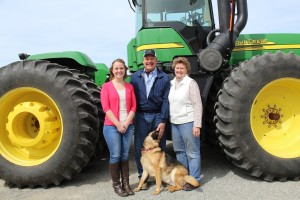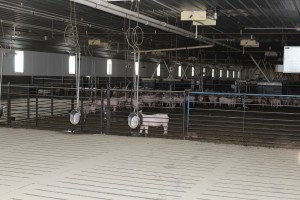GREENWICH, Ohio — After working more than 30 years as an engineer in the automotive industry, Huron County farmer Howard Krikke went back to his roots in 2006.
He and his wife, Jane, both grew up in farming and have had their own farm since the mid-1980s. When the automotive industry began slowing down, he returned to farming full-time.
But “going back” for the Krikkes also meant going forward.
Instead of just crop farming — which was in both of their backgrounds — Howard and his wife took on a new venture: swine production.
“I looked at it as a business,” he said. “Could I do a cash flow of this thing, could I make money with it, and could I do it right.”

Their first double-wide swine barns were built 10 years ago, and today the Krikkes finish about 10,000 head a year, as contract producers for Kalmbach Feeds. They also farm about 1,000 acres of corn and soybeans.
Their daughter, Emily, is 25 and works three days a week as a registered nurse in Akron. On her days off, she helps on the farm.
Engineering skills
Howard’s background in engineering helped him when he worked for General Motors and Ford — and it also helped him plan and maintain his swine operation.
His swine barns are strategically located about a half-mile off U.S. Route 224, and are bordered by a woodlot, that helps to block wind and filter any odors. In back of the barns is a wet area that acts as a natural water recharge system — collecting clean runoff water from the roofs and driveway, and percolating back into the ground.
The manure from the barns is applied to his crop ground, injected beneath the surface, and provides a source of fertilizer.
“We kind of have a natural cycle,” Howard said.
He estimates that his hogs use about 2.5 million gallons of water a year, but he says he’s putting nearly double that amount back into the water system by diverting runoff into the recharge system.
Conservationists
Howard and Jane’s dedication to conservation earned them the Ohio Livestock Coalition’s Environmental Stewardship award in 2012, and in 2013, they were awarded a national Environmental Stewardship Award by the Pork Checkoff.

The Krikkes focus on four stewardship values: ensuring an abundant food supply, providing for quality of life and making a profit, civil relations and preserving natural resources.
As Howard puts it, “We want people to drive by and say ‘that’s the kind of place where I want my food raised.’”
Because the manure is injected, and because the barns are strategically located, odor is kept to a minimum. But the Krikkes work with their neighbors and also take some free pork to them each year, to help keep good relationships.
Nutrient management
Howard does field nutrient testing to determine how much manure each field needs, and he follows a comprehensive nutrient management plan, which helps ensure nutrients are being applied properly, and kept out of the watershed.
The nutrient issue is especially important to the Krikkes, since their water drains north, toward Lake Erie.
His farm is just east of the Western Lake Erie basin, where new manure regulations were recently put in place. But he tries to farm the same way as those being regulated — knowing that down the road, he could be.
“If we don’t do a good job, regulations are coming,” he said. “We have to be, as farmers, conscientious of what we do. We can’t just throw it on the ground and walk away. We’re responsible for what happens.”
Producing swine
As part of the contract, the Krikkes own the farm and buildings, while Kalmbach Feeds owns the hogs and provides the feed and veterinary care. The barns are divided into large, 625-pig pens, and the pigs are sorted through a computerized scale system known as auto-sort, which weighs and sorts them according to their weight.

The automated sorting system makes handling the swine less stressful for the animal and the farmer, and the Krikkes feel it’s been a key contributor to their low mortality rate.
But modern swine farming is still “hands on … in there with the pigs,” said Jane Krikke.
The Krikkes can medicate individual hogs on their own, but for broad medication, they rely on a veterinarian.
“We’ll do whatever we can, within reason, to try to save an animal or take care of it,” Howard said.
One of the things they do for their hogs is enforce biosecurity. Most people are not permitted near the barns, due to the risk of carrying in harmful bacteria, and those who do enter, have to comply with strict sanitation rules.
In addition to Emily, the Krikkes have two other daughters, Kate and Molly. A fourth daughter, Laura, died when she was 6, from childhood cancer.
Although Emily is committed to nursing, she said “farming is in my blood,” and something she can’t get away from.
She is a past American FFA Degree recipient and said she enjoys telling patients about farming, when she’s at the hospital.
More improvements
Looking ahead, Howard wants to make additional improvements to the barns, including a new computer monitoring system that will include camera monitoring, and have wifi access in the barns. If he decides to expand, he has the ground to do that, as well.
Whatever the farm does next, it will be well-engineered.
Howard said it’s been a “win-win” to have farming and engineering in his background. Farming has given him the practical knowledge to know what works, and engineering taught him how to take his ideas a step further.
But one thing he still can’t engineer is the weather — nor the challenges of everyday life.
“We don’t really own this ground, we pay expensive rent for it is what we do,” he said. “This is all God’s creation and we feel fortunate to be able to work with it, and we owe Him the responsibility to do our best with it.”











